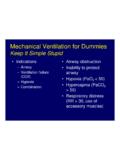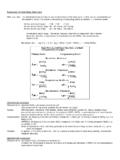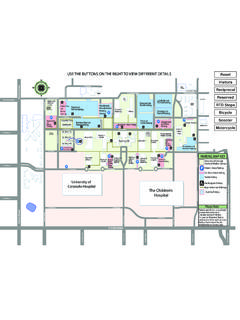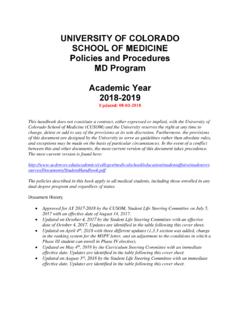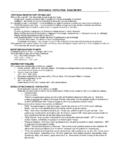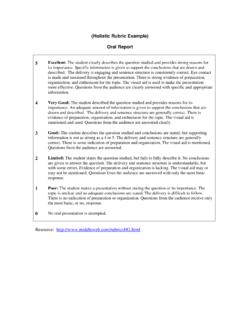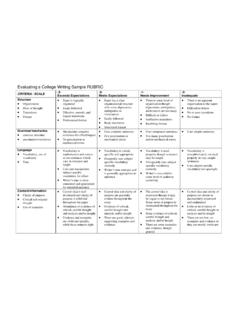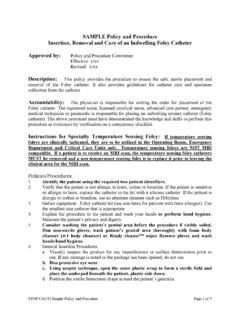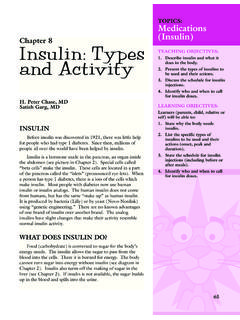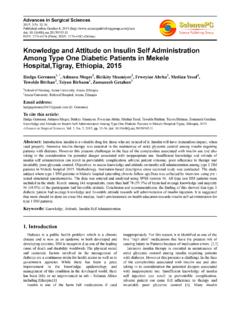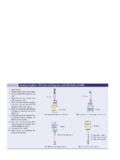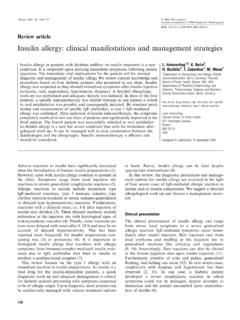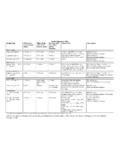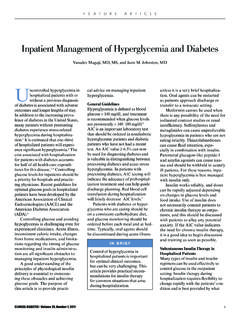Transcription of 1. Present the principles of food management related to ...
1 TOPICS:FoodManagementand DiabetesTEACHING OBJECTIVES: 1. Present the principles of foodmanagement related Explain the significance ofcarbohydrates (carbs) indiabetes Discuss types of meal planningapproaches including OBJECTIVES:Learners (parents, child, relative orself) will be able to:1. List three objectives of Describe examples ofcarbohydrate (carb) containingfoods and their effect on bloodsugar the type of food planyou will be 12 FoodManagementand DiabetesH. Peter Chase, MD Gail Spiegel, MS, RD, CDEFood (mainly carbohydrate [ carb ]) is one of the majorinfluences on blood sugar levels in people with diabetes. Asdiscussed in Chapter 2, the body (particularly the liver) alsomakes sugar (internal sugar), which adds to the blood sugars (external sugars) come from the food we for the use of sugars for people withdiabetes have changed.
2 It has gone from avoidance to allowingsugar within the context of a healthy meal plan. As discussed inChapter 11, the right amount and types of food are essentialfor normal growth and health. TYPE 1 ( insulin -DEPENDENT) DIABETES CANNOT BE TREATEDWITH DIET ALONE. In contrast, type 2 diabetes cansometimes be treated with diet and exercise OF FOOD MANAGEMENTNo matter which of the food plans are used, the objectives offood management are the same:to balance insulin and carb intake in order to keep theblood sugars as close to normal as possibleto keep the blood fats (cholesterol and triglycerides) andlipoproteins (LDL and HDL) at desired levelsto improve overall health by maintaining the best possiblenutrition115116 Chapter 12 Food management and Diabetesto help avoid long-term complicationsto help attain normal growth anddevelopment for children and appropriateweight for everyoneto help prevent severe hypoglycemiaIt is amazing how often we hear parentscomment, My child with diabetes is thehealthiest in our family BECAUSE HE/SHEEATS THE BEST.
3 Although this is notproven, it may be true. Good nutrition for aperson with diabetes is really just a healthy dietfrom which allpeople would on food management for people withdiabetes have changed considerably. There wasa time when some diabetes care providersbelieved every family should rigidly be given anADA exchange food program. In 1994, the Position Statement of the ADA stated: Today there is noone diabetic or ADA diet. The recommended foodprogram can only be defined as a dietaryprescription based on nutritionassessment and treatment goals. Medicalnutrition therapy for people withdiabetes should be individualized, withconsideration given to usual eating habitsand other lifestyle changes. This has been the philosophy of the 11editions of this book over the last 30 DCCT (Chapter 14) also contributedto our knowledge about food and diabetes. Inthe DCCT, six main nutrition factors werefound that contributed to better sugar control(lower HbA1clevels, Chapter 14).
4 The six main nutritional factors were:1. following some sort of a meal plan2. avoidance of extra snacks3. avoidance of over-treatment of low bloodsugars (hypoglycemia)4. prompt treatment of high blood sugarswhen found5. adjusting insulin levels for meals 6. consistency of night snacksThe DCCT did NOTreport that one typeof meal plan was any more effective major meal planning approaches we useto help people manage diabetes are discussedbelow. Most families start with a constant carbfood plan. In recent years, carb counting hasbecome more popular. We tend to emphasizethis plan. Some families will change from oneplan to another or use a combination of plansthat works for OF MEAL PLANNINGAPPROACHESD ifferent types of meal planning approacheshave been used for people with diabetes for about4,000 years. They are talked about in an ancientscroll called the Ebers Papyrus which waswritten about 2000 In 1993 the DCCT showed that people with diabetes who followed adietary program had better sugar control thanthose who didn t.
5 There are now many types offood management plans for people with food management plans require people to payattention to carbs. Over 90 percent of carbseaten are converted into blood glucose (sugar)over the next one to two hours. Meats (protein)and fat have very little conversion to blood three of the food plans discussed below payspecial attention to two approaches used most commonly in ourClinic are:1. Constant Carbohydrate (Carb) Meal Plan 2. Carbohydrate (Carb) Counting Meal PlanA third approach, the Exchange Meal Plan, issometimes used for type 2 clinic caring for the person with newlydiagnosed diabetes may prefer one type of mealplanning approach over another. It may beunnecessary to read about the other approaches,at least initially. The purpose of all meal plans isto achieve better control of blood sugar method that works best for one person maynotbe the best for someone 12 Food management and Diabetes117 Any of the meal planning approaches canwork.
6 No single approach has been provenbetter than any other in achieving good bloodsugar control. It is up to each healthcare teamand family to eventually decide which approachworks best for them. Some families will switchfrom one approach to another or combine partsof each to fit their needs. Many families initiallyuse the constant carb food plan. They thenmove to adjusting rapid-acting insulin for carbsto be eaten (carb counting) as they gainconfidence, knowledge and carb counting is important to meet with a registered dietitianto develop a meal plan that meets your management OF CARBINTAKE MUST BE PART OF ANY OFTHE PROGRAMS. IT IS IMPOSSIBLETO EAT VARYING AMOUNTS OFCARBS (WITHOUT CHANGING THEINSULIN DOSAGE) AND KEEP THEBLOOD SUGAR FROM FLUCTUATINGUPOR DOWN. Knowing how many carbsare being eaten is important in any meal plan. 1. Constant Carbohydrate (Carb) Meal PlanIn the constant carbohydrate meal plan, theamount of insulin (usually two or four shots perday) is kept relatively constant from is done to match relatively consistent foodintake.
7 The amount of carbs (types can vary)is kept about the same for each meal andeach snack from one day to the next. Oftenfamilies begin by using the constant carb mealplan. They then move to adjusting insulin forcarbs as they gain confidence and must be read to know the grams (g)of carbs being eaten (see label reading, Chapter11). The dietitian may give a range of carbs foreach meal. This might be 45 to 60g/meal for apre-teen. A teenage boy might have a range of60 to 150g/meal. CONSISTENCY IS constant carb meal plan is formedaround the 10 principles discussed later in thischapter and is then amount of food eaten at a meal or snack mayvary with: 4expected (or completed) exercise4insulin taken4blood sugar level More carbs may be needed (withoutincreasing insulin ) for fun activities such assports, hiking and biking. For work relatedactivities such as ranching and farming, morecarbs may also be needed.
8 However, thenormal eating pattern of the child and thefamily should stay the same as much as often ask, How many carb choicesare appropriate for me/my child? They cancount carbs even if insulin adjustments are notbeing made to match the carb intake. This helpsto keep the carbs eaten at each meal numbers of carb choices to be eaten at eachmeal can be estimated by looking at Table numbers of calories needed per daycan be calculated from the formula in the sectionon Calculating Calories in this chapter (or askyour dietitian). The usual number of carb choicesfor the level of calories per 24 hours can be seenin the dark print in Table 4. The formulas are aguide and each person s calorie and carb needscan be different. We recommend consulting witha dietitian to establish a plan that works for Carbohydrate (Carb) Counting Meal PlanCarb counting involves counting the gramsof carbs that are to be eaten and giving amatching dose of insulin .
9 It allows for greaterfreedom and flexibility in food choices. It isoften used with intensified diabetesmanagement. This can be with multiple dailyinsulin injections or with insulin pump is not possible to count carbs withoutlearning to read food labels (Chapter 11). Carbcounting is both similar to and different fromthe constant carbohydrate meal to the Constant Carbohydrate MealPlan:Similarity ..4It emphasizes carb intake and keepingprotein and fat relatively 12 Food management and DiabetesDifference ..4It presumes that carb intake (and insulindose) will vary, thus providing more flexibilityand greater safety from may involve more injections of insulin asextra rapid-acting insulin is taken to covercarbs eaten. Some people take rapid-actinginsulin when 15g or more of carbs areconsumed, while others cover even loweramounts (5g or 10g) of carbs. This shouldbe discussed with your to the Exchange Meal Plan:Similarity.
10 4similar-sized exchanges of carbs are usedDifference ..4protein and fat exchanges are not usedHaving the correct insulin dosage to covermeals and snacks is now receiving increasedattention. One research study in adults withtype 2 diabetes found that half of the elevationin HbA1cwas due to the high blood sugars 1 gives summaries of foods equalingonecarb choice. One carb choice is theamount of each food equal to 15g of carb. Itmay be helpful to copy Table 1 initially andcarry it in a wallet or counting involves counting the gramsof carbs to be eaten and taking a matchingamount of Approaches:Some people prefer to just think of thenumber of grams of When using an insulin to Carb ratio (I/Cratio) one usually thinks in grams of , the conversion to 15g choices is notreally needed. An example of an I/C ratiois 1 to 15 (1/15). This refers to one unit ofinsulin per 15g of carbs eaten (or to beeaten).
